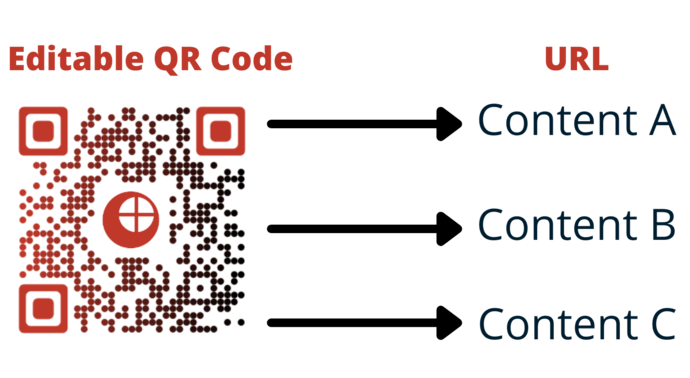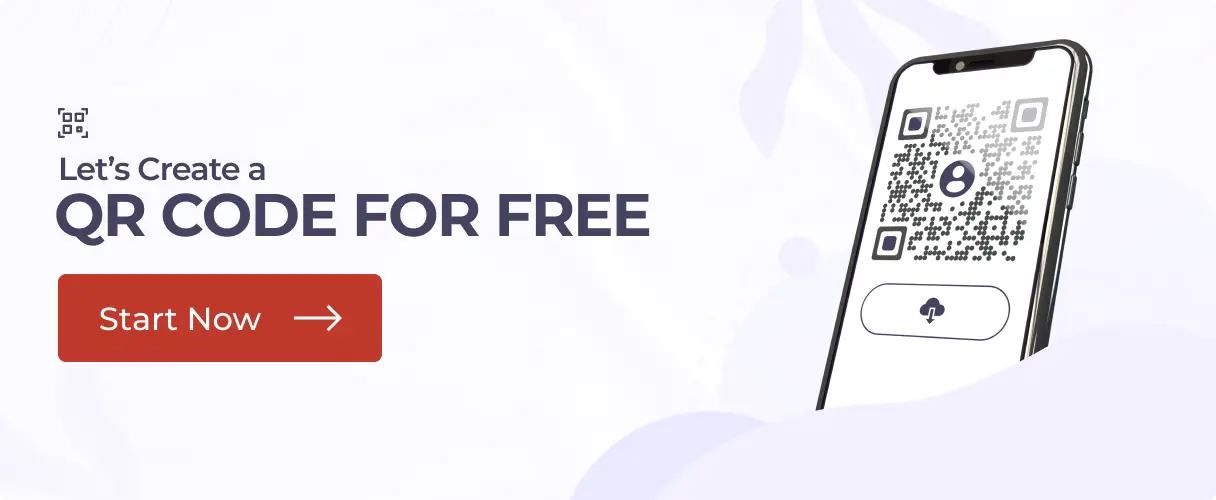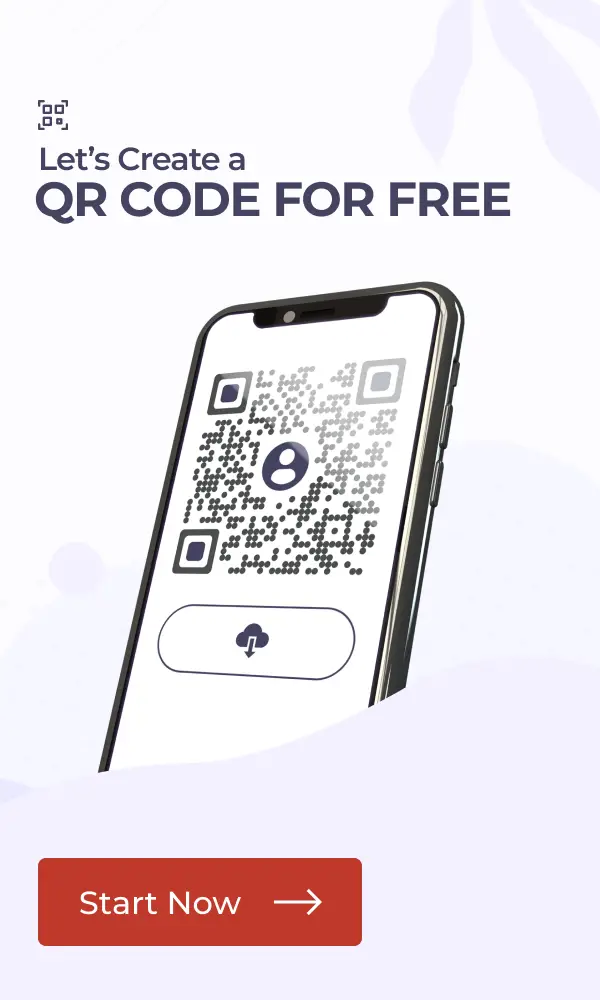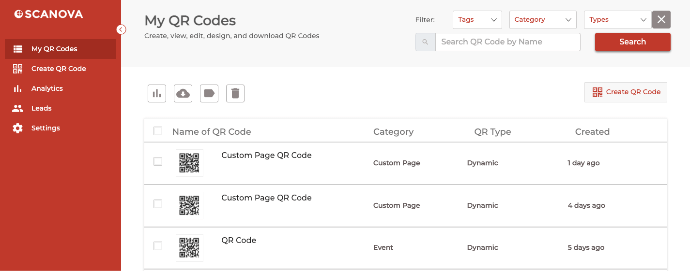In a nutshell: Learn about editable QR Codes, also called dynamic QR Codes, in this complete guide. Find out how to create, edit, and track scan codes that let you update content anytime. Explore key benefits, real-world use cases, top tools, and tips for managing QR Codes effectively.
You probably know what QR Codes are. They are square-shaped 2D barcodes that store information. From text and alphanumeric characters to multimedia, they can store it all.
You’re probably thinking of using QR Codes in one of your campaigns. And you’ve stumbled upon the fact that QR Codes can be edited. Well, that’s right. These are called Dynamic QR Codes.
Dynamic QR Codes are not only editable but also trackable. Keep reading to know more about them.
Also read: Types of QR Code
A. What is an editable QR Code?
An editable QR Code is a type of QR Code that allows you to change the destination content even after the code has been printed or shared. Unlike static QR Codes, editable QR Codes offer flexibility, analytics, and superior design scalability.
How it works:
Editable QR Codes don’t store the final data. Instead, they store a short redirect URL hosted on the backend server of your QR Code generator platform. This redirection acts as a pointer to wherever you want your users to land.
Because the destination is not hardcoded, you can change it anytime from the platform’s dashboard. For example, you can switch from a landing page URL to a PDF, a YouTube video, or even a custom form—all while using the same printed QR Code.
Real-life analogy:
Think of editable QR Codes like your personal assistant. Say you hand someone your business card with your assistant’s number. You can later ask your assistant to redirect calls to your office, home, or hotel—without changing what’s printed.
Key components:
- Short URL/Redirector: Hosted on a platform like Scanova
- Backend Access: To manage and monitor the QR Code
Analytics Engine: Tracks scans, devices, and locations
In addition to this, these QR Codes also allow you to monitor their scanning activity. That means you can see details such as how many people scanned your QR Code, exactly when they did it, and where they did it from.
B. Difference between editable QR Code and static QR Code
Do you know that not all QR Codes can be edited? Well, depending on the editability, QR Codes are of two types: Dynamic and Static.
You already know what a dynamic (editable) QR Code is. Now let’s see how a static QR Code works.
Static QR Code
As the name implies, these QR Codes are static in nature. That means they are permanent, and the data stored in them cannot be edited.
Unlike dynamic QR codes, static QR Codes store the target content directly. This limits you from adding as much data as you want. You can only store up to 7,089 characters in a static QR Code.
Also, to edit the stored data, you’ll have to create a new QR Code from the scratch. And finally, static QR Codes don’t allow you to monitor their scanning activity.
Related: Types of QR Codes
| Feature | Static QR Code | Editable (Dynamic) QR Code |
| Editable after creation? | No | Yes |
| Scan analytics? | No | Yes |
| Password protection? | No | Yes |
| File size & density | Larger if the data is complex | Small and clean |
| Content flexibility | None | Multiple destination types |
| Design customization | Limited | Advanced options |
| Use case suitability | Short-term, personal | Business, campaigns, enterprise |
Static codes are great for simple, one-time links. Editable QR Codes are ideal for anything you’ll need to update, analyze, or scale.
C. Why use editable QR Codes?
Editable QR Codes offer a wide array of functional and strategic benefits:
1. Update content anytime
Whether your campaign offer changes or you need to redirect traffic elsewhere, editable QR Codes save you from reprinting costs. Just update the backend link.
2. Access deep analytics
You can measure:
- Total scans
- Unique scans
- Date and time of scan
- Device type
- Geolocation
This helps optimize your strategy using real user data.
3. Enable security features
Editable QR Codes support:
- Password protection
- Device restrictions
- GPS-based locking
- CAPTCHA or lead generation gating
4. Maintain design consistency
Static QR Codes become dense as you encode more content. Editable codes store a short URL only, so they remain clean and scannable. This means you can:
- Add your brand’s logo
- Choose colors
- Use patterns that fit your design system
5. Cost-efficient long-term
Once printed, an editable QR Code can be used for years without replacement. Especially useful in product packaging, signage, business cards, and permanent displays.
6. Enable A/B Testing
Change destinations based on campaign goals to test CTAs, formats, or user flows, and evaluate performance using scan metrics.
D. 10 use cases of editable QR Codes
Editable QR Codes can be used across industries. Here are 10 in-depth applications:
1. Marketing campaigns
Promote seasonal offers, switch out campaign links, or deliver coupon codes that change monthly.
2. Education
Share course materials, replace old class links with updated content, or link to registration forms dynamically.
3. Real estate
Attach a QR Code to a signboard and change the linked property as availability updates. Include virtual tours, photos, and agent info.
4. Healthcare
Use editable codes for patient appointment forms, vaccination updates, or hospital entry protocols.
5. Logistics
Generate one QR Code per package. Let the destination change to reflect real-time tracking or updated contact details.
6. Events
From RSVP to post-event feedback, editable QR Codes allow you to switch between registration forms, venue maps, and speaker bios as the event timeline evolves.
7. Retail
Use codes on receipts or packaging to share new offers, product instructions, or feedback forms.
8. Restaurants
Daily menus, chef’s specials, and reservation systems—all can be managed using a single editable code.
9. Human resources
QR Codes in onboarding kits can link to dynamic handbooks, training schedules, or policy updates.
10. Product packaging
Deliver different manuals or video tutorials based on seasonal campaigns or customer location.
E. Benefits of using editable QR Codes
In comparison to static QR Code, editable QR Codes offer various benefits:
1. Best for long-term use: You can edit the content in an editable QR Code whenever required. without a need to create a new one
2. Track the scans, their location, and scanning devices: You can monitor the behavior of your end-users. It gives detailed insights into how your business campaign is working. Based on the scanning analytics, you can optimize your future campaigns accordingly, too
3. Protects the information with a password: Editable QR Code also offers additional features such as password protection. It means when end-users scan it, they’ll have to enter the password to see the encoded details
This feature is especially useful if you want to share confidential information via QR Codes.
4. Saves time and effort: Again, you don’t need to create a new QR Code every time you wish to edit the data. You can do it in a few simple clicks
5. Go a step ahead of barcodes: Once the information is stored, it becomes fixed in barcodes. And as we’ve discussed, editable QR Codes overcome this barrier
6. Keep the QR Code clean: The static QR Code becomes dense when the encoded content increases
But a dynamic/editable QR Code stores only short URLs and doesn’t become dense irrespective of how much data you encode This also increases the scannability of your users.
Related : QR Code For Link
F. How to generate an editable QR Code?
You’ll need an advanced QR Code generator to create an editable QR Code. And here’s a list of the best QR Code generators available online. You can go through it to decide on the best one for yourself.
Using Scanova for a demo, here’s how to generate an editable QR Code:
1. Go to Scanova and select the most relevant QR Code category for your use case. For a demo, we’ll be creating a Website URL QR Code
2. Select Website URL category
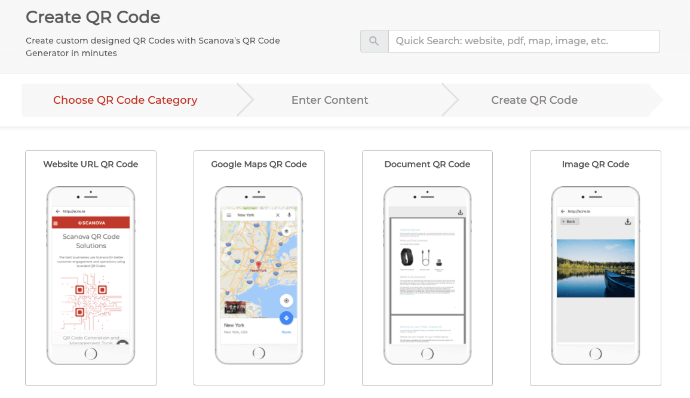
3. Enter the link to be encoded and click on Continue
4. Next, on the page that loads, name your QR Code and proceed ahead
5. On the next page, you’ll see two QR Code design options. You can choose from a custom QR Code with the logo or a custom QR Code with the background
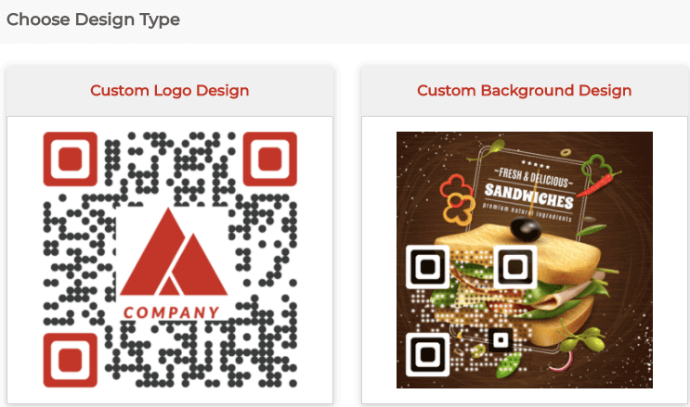
6. Once you’ve decided on design or no design (by not choosing either of the two design options), proceed to download
7. Now you’ll see a pop-up prompting you to sign-up for a free trial. Note that you won’t have to enter card details to sign-up
8. Once the sign-up is done, click Download your QR Code
9. A window will pop up. Here, specify the image format and size for the QR Code to be downloaded. Once done, click on Export
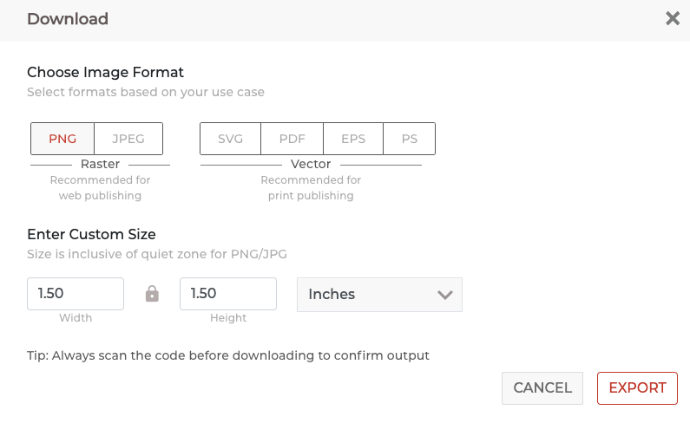
Your editable QR Code will be generated.
G. How can you edit the dynamic QR Code?
Here’s how to edit the data encoded in a QR Code using Scanova:
1. Login to your Scanova account and go to the My QR Codes section
2. Select the QR Code which you want to edit:
Name: Here, you can change the name of the QR Code
Category: Using this feature, you can switch the QR Code category—Website URL QR Code, App Deep Link, App Store, Audio, Coupon, Custom Page, Document, Event, and more
Tags: Here, you can add more tags
Below this, you will see more options such as:
Content: You can edit the content you linked to a QR Code
Advanced Settings: You can enable password protection, GPS location, and lead generation
Design: You can edit the design again the way you want to
3. Make the required changes and click Update QR Code.
You are done! Your QR Code will be updated in no time. That’s all about editable QR Codes.
You can now go-ahead to create your first editable QR Code.
H. Best practices for managing editable QR Codes
Editable QR Codes (also known as dynamic QR Codes) are flexible and powerful—but only when managed correctly. Here’s how to keep your QR strategy clean, efficient, and future-proof:
1. Use clear naming conventions
Always give your QR Codes descriptive names like Campaign_Summer2025_Discount10 or Flyer_TradeShow_Mumbai2025. This makes it easy to track, edit, and report results, especially when managing dozens or hundreds of codes. Avoid generic names like “QR_Code_1” that create confusion later.
2. Group codes using campaign-based tags
Most professional QR platforms allow you to tag or organize codes into folders. Use this to your advantage. For example:
- Use tags like EmailCampaign, InstorePromo, or HolidaySale2025
- This helps with quick access and group-level analytics
It’s especially useful when you’re A/B testing or comparing different campaigns.
3. Enable scan alerts to monitor performance
Set up notifications for scan activity—daily, weekly, or real-time—depending on your campaign’s goals. This helps you:
- Spot sudden spikes or drops
- Respond quickly to underperforming links or expired content
- Keep stakeholders informed of campaign progress
4. Regularly back up QR Code data
Most QR Code platforms store all your links and analytics on their servers. But just in case you switch providers or experience downtime, export your QR Code data regularly—especially for active or critical campaigns. Backups ensure you never lose important links or stats.
5. Test the QR Code after every edit
Every time you change the URL or destination behind a QR Code, scan it yourself. Make sure it:
- Loads quickly
- Leads to the correct page
- Works on both Android and iOS devices
- Has mobile-friendly content at the destination
This step is often skipped, and that’s where campaigns break.
6. Avoid too many design customizations
Yes, branding matters. But too much customization (like heavy logos, wild colors, or low contrast) can reduce scanability. Stick to high-contrast foreground and background colors, and always test the design with multiple scanner apps before printing or publishing.
7. Set expiration dates for short-term promos
If you’re running a limited-time offer or seasonal campaign, set an expiration date or redirect rule. This helps:
- Prevent users from landing on outdated pages
- Redirect traffic to a fallback or evergreen offer later
- Keep your analytics clean and current
I. FAQs about editable QR Codes
1. Do editable QR Codes expire?
Editable or dynamic QR Codes don’t expire on their own. However, they’re tied to the platform where they’re created. If your account on that platform is downgraded, expires, or is manually deleted, the QR Code may stop working. Always choose a reliable provider and keep your subscription active to avoid issues.
2. Can I redirect the QR Code to a new link?
Yes, and that’s the biggest advantage of editable QR Codes. You can easily change the destination URL without changing the QR Code itself. For example, if you printed a code linking to an event page and now want it to go to a thank-you page after the event, just update the link in your dashboard. No need to reprint anything.
3. Are dynamic QR Codes trackable by default?
Absolutely. Most editable QR Codes come with built-in tracking. You can see how many times the code was scanned, when it was scanned, what devices were used, and even general location data. Platforms usually provide a visual analytics dashboard to help you measure performance and improve campaigns.
4. Is there a scan limit?
This depends on your QR Code platform’s pricing plan. Free plans often come with scan limits, while paid plans usually offer unlimited or high-volume scans. If you expect a lot of traffic, like for national ad campaigns or product packaging, go with a plan that fits your scale.
5. Can I host my own dynamic QR Code system?
Yes, but it’s not plug-and-play. To create a self-hosted editable QR Code system, you’ll need:
- A custom short URL domain (e.g., qr.yourbrand.com)
- A server-side redirect system to manage destination URLs
- A database to store and update links
- Optionally, a basic analytics system to track scans
J. Common mistakes to avoid
Even though QR Codes seem simple to use, small missteps can make them ineffective or even unusable.
Let’s break down the common pitfalls and how to avoid them, especially if you’re using QR Codes in marketing, events, packaging, or business workflows.
1. Using static QR Codes for editable campaigns
If you’re planning to update your content later (like changing a URL, campaign details, or offers), never use a static QR Code. Static codes are permanent—once printed or shared, the content they point to can’t be edited.
What to do instead:
Choose a dynamic QR Code. It lets you change the destination link later without having to reprint the code. It’s a lifesaver for seasonal campaigns, event pages, or product updates.
Real-life example:
A café printed flyers with a static QR Code linked to their old menu. After updating their offerings, they had to reprint everything. A dynamic QR Code would’ve allowed a quick link switch—zero reprints needed.
2. Not testing after making edits
Just because you can edit a dynamic QR Code doesn’t mean it always works flawlessly afterward.
Why this matters:
Sometimes the redirect doesn’t save properly, or there’s a caching issue. A broken QR Code can ruin user trust—and your campaign ROI.
Best practice:
After making any edits, scan the QR Code yourself on multiple devices (iOS, Android, different browsers) to make sure it works. And have a friend or colleague do the same.
3. Ignoring scan analytics or data tracking
You can’t improve what you don’t measure. If you’re using dynamic QR Codes and not looking at scan metrics, you’re missing valuable insights.
Why it matters:
You can track:
- How many people scanned your code
- From which location
- At what time
- On which device
This helps you:
- Measure ROI
- A/B test campaigns
- Understand user behavior
- Justify your marketing budget
Tip: Use Scanova for real-time analytics dashboards or integration with Google Analytics.
4. Over-designing the QR Code
Sure, it’s tempting to make your QR Code match your brand colors, add a logo, and shape it like a circle or triangle. But too much customization can make it hard to scan.
Common design flaws:
- Poor contrast between foreground and background
- Overlaid logos blocking key patterns
- Odd shapes that confuse scanners
Keep in mind:
A QR Code is a functional tool first. A good rule of thumb: test the design before printing it in bulk. Also, always leave enough white space (called quiet zone) around the code.
5. Using Platforms Without Export or Migration Options
Some QR Code generators lock you in. If the platform goes down or you want to switch providers later, you’re stuck.
Why is this risky?
- You can’t move existing code elsewhere
- If the provider shuts down, your QR Codes might stop working
- Some don’t let you download high-resolution or vector files
What to look for:
Use platforms that offer:
- Full data ownership
- Vector exports (SVG, EPS, PDF)
- Domain redirection or custom short URLs
Pro tip: Read the platform’s terms of service. Look for mentions of migration, export, and permanent code redirection.
Conclusion & Key Takeaways
Editable QR Codes are an evolution of static ones, offering power, agility, and insight. With their ability to adapt in real-time, they’re essential for any professional marketing, logistics, or educational use case.
- Update content anytime
- Track scans and user behavior
- Customize appearance to fit the brand
- Secure and scalable
👉 Try Scanova for Free — No Credit Card Needed
Editable QR Codes are not just about links—they’re about control, data, and agility.
By embracing them, you’re giving your users the best scanning experience while keeping full control over what they see.
